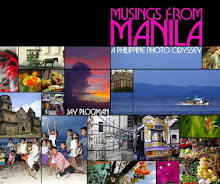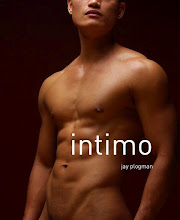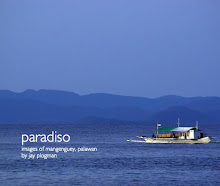These images and an accompanying article were published in the Philippines' only online gay magazine, Outrage. Here's the article and some of the pics from the shoot:

“They’re still decent,” Jay Plogman says, smiling, “so you can interview them, if that’s what you want.” We were in a studio in Makati City, dropping by, as requested, to supposedly see him in action, taking photographs that will “highlight Filipino men,” he says, since “it really doesn't matter if they are gay or not, (but) it's no secret that Asian men, in general, are marginalized when it comes to their presence in (the) media. Even here in the Philippines, only white men or the fairest-skinned mestizos are deemed worthy of being in advertising campaigns, magazines, et cetera. So I hope that through (these) photographs, people will begin to see that guys (and girls) can have dark skin, et cetera, and be really good looking, and worthy of the same presence.” Casually garbed in dark blue T-shirt on top of dark shorts, he was Sunday personified, even as he was quite adamant in saying that he prefers for his photographs not to be seen as “gay” or have necessarily anything to do with the gay community, since in photographs he takes, even those “inherently gay,” he, more than anything, says something about the people portrayed in it, or the characters played in it, “in a positive light, showing how normal it all is,” he says.
He then excused himself, walking barefoot towards the inside of the studio, off to check his equipment. His boyfriend Edson stays behind to make small talk on how the shoot should, hopefully, help shift impressions on beauty – a theme Plogman almost always approaches with gusto, especially here in the Philippines, where he is based now. Padding back to where we were, if only to inform us that the photoshoot is about to start, Plogman starts giving some instructions to his models – Edson moves to where they were, to help out, I suppose, as off they went to put flesh in Plogman’s vision. But how, exactly, did the country end up having an adept photographer cum advocate in the person of Plogman?


STARTING YOUNG
Everything started when he was younger, when Plogman recalls getting excited by photography, especially “when I (saw) my father bring out his 35 millimeter (mm) camera to take pictures on a family vacation, (and) I knew they’d be something special – there was something about that camera and the images it took that I perceived as better than what my mom and I got from our 126 and 110 cameras. Dad's was a ‘real’ camera, and I couldn't wait until I was old enough to have one of my own,” he says. He got “old enough” to have his own camera when he was in high school, “when I saved up enough to buy a used Fujica 35 mm all-manual single-lens reflex (SLR) camera.” It helped, too, that one of his high school teachers was an avid photographer. In hindsight, Plogman “originally took up photography because I loved to photograph trains. They're still one of my favorite things to photograph – nature and what I loosely term ‘travel’ are others. Yes, people are also some of my favorites, but shooting nature, architecture, or trains is very spiritual and therapeutic. The zen calm of nature, geometry of architecture (and the play of light on both), and the power of a train. So (it’s) work I get to do alone, just myself and the camera.” In college, Plogman studied visual arts, familiarizing himself with theories and practice of, among others, painting, drawing, theory, history, sculpture, and, yes, photography. “The lessons I learned from all of those disciplines are employed every time I pick up the camera to take a picture,” he now says, adding that good knowledge base is important since “photography today can be a daunting profession to enter, since every time you move, you're starting over from nothing. There are the established professionals working in every city in every country to compete with, plus it seems every person who buys a digital SLR camera thinks that makes them a professional photographer.” Among Plogman’s credited influences are “masters including O. Winston Link in railroad photography, Robert Mapplethorpe in nature and nude, Nan Goldin in real-life portraits, and, lately, Richard de Chazal for manipulative photographic work. I'm also heavily influenced by writers such as Mark Twain and Oscar Wilde; and the comedian Jack Benny. I know it isn't readily apparent how they affect my photography, but they do,” he says. Plogman recalls, too, how, “for my first 17 years in photography, the only things digital were watches,” he says, noting how “digital imaging is in many ways a great advance, but it is also a great obstacle. I'm not the type of person who takes to computer features easily. Personal computer (PC) or Mac, none of it is intuitive at all to me. Going from film to digital and using editing software instead of simply reading a negative or slide and making corrections in printing has been a long process for me. I'm so lucky I can use both, and I feel the strength I and other pre-digital photographers have over those who know only digital.” He adds: “With film (especially when shooting slide films like Fujichrome or Kodachrome), a photographer has to do everything right the moment the picture is taken. As a result, those ‘old timers’ get it right on the first take. Those photographers in Luneta are FAR more talented than the public gives them credit for; and using equipment often over 30 years old. People today think of a camera as obsolete after a couple years.”
FOREIGN LOCALIZED
“The Philippines is fascinating, depressing, delightful, and much more... much like any other place I've been. That's not to say the Philippines is the same as other places; IT ISN'T! But I've traveled to many other countries around the world and have always found some quality in each that I admired or thought should be adopted in the US to make life there better,” Plogman says.



BEAUTY IS EVERYWHERE.
Jay Plogman believes he offers a different point of view (call it Western, if you may, he says) in his photographs.
Interestingly, Plogman says that the Philippines, especially Metro Manila, “is the gayest place I've ever been. It makes San Francisco look straight. My boyfriend and I have never seen so many obviously gay guys in one place, holding hands on dates in Gateway and Glorietta Malls (GAYway and GAYetta),” he says, smiling.
Not that the local gay community, if it can be called that (“I'm disappointed it isn't more of a community; just obnoxious little clans,” Plogman says), is all ideal. For one, “it would help if gay Filipinos would just admit they are gay to begin with. One gay social networking site I checked had seven of 10 Filipinos claiming to be bisexual. The Philippines is the only country on this planet to claim such. Most other countries have only a single-digit percentage of people claiming to be bisexual. Don't even bother mentioning the variety of ‘meanings’ Filipinos give to the word ‘bisexual’! That's bullshit, (for there) is only 1 meaning: you are sexually attracted to BOTH men and women. Gay Filipinos will never enjoy respect, tolerance, or acceptance until they can admit to themselves they are gay,” Plogman says.
And while “it's 2008 and it has never been easier to meet other gay people; no longer is the gay community one that exists just underground, in the shadows of alleys in the night,” due to the “outdated, bigoted views of the Roman Catholic Church, so many Filipinos still can't live their lives the way that's best for them and their happiness.”
And while he laments that like in cities like New York, Metro Manila's gay community suffers from the problem of guys constantly on the search for someone better than the boyfriend they already have (“Look guys, there's ALWAYS going to be someone better-looking, richer, et cetera. Get over it. FIND and LOVE the one who LOVES YOU”), he is still glad to have been “blessed to have met mostly great people here. I've met my share of cheating, lying, petty, gossips as well; but the number of talented, educated, interesting, caring, lovely people far outnumbers them,” he says.
LOOKING FORWARD
Plogman, who admits loving writing (“I blog – I realize that sounds odd, and it makes me no money, but I love to write, and my blog allows me to share my experiences here in the Philippines”), recalls one time, in 2000, when a neighbor asked “if I'd shoot him and his boyfriend having sex. That wasn't as weird as waiting while I listened to him try to ask the question. He was so nervous, I think it took him almost five minutes,” he laughs.
He tries to be flexible, though, even if “there are clients who I'll refuse due to uneasy feelings I get around them. Some don't want to be photographed; they want me. There are also those who ask for the unreasonable, or those who ask for particular types of photography I don't have the proper equipment to shoot.”
This early, “I can't say I have had any one defining achievement that has been more satisfying than any others. I look at each shot as an achievement. If I'm able to capture some unique aspect of each person, interpret something or some place in a unique or special way that says something to others, and have people react positively to these, that's achievement enough,” Plogman says.
For now, though, the focus remains in coming up with good pieces – not just advocating beauty, but advocating advocacies, a seemingly easy enough endeavor for Plogman who says his style is quite straightforward. “The fact
that I don't need to do this give me a competitive edge,” he says, “and since I
don't need to do this, I am a lot less stressed. That also allows me to charge less than other photographers here. I haven't the long-established reputation some have, and I know my time in the Philippines will end in approximately a year; so I needn't charge higher rates. I'm not looking to take away anyone else's business, anyway. Just so I just charge enough to make it worth my while.”
Back in the studio, shooting almost naked Filipinos, Plogman quips how he’s looking at coming up with a book (“Hopefully, the images I create during my time here will be something I can organize into a book in the future”), he says. That’s relatively long way away still, however.
So for now, he shoots “in a style that is from a different point of view – call it Western, if you will,” highlighting how Filipinos can really be beautiful.
Now, if only Filipinos start seeing themselves the way Plogman sees them.












